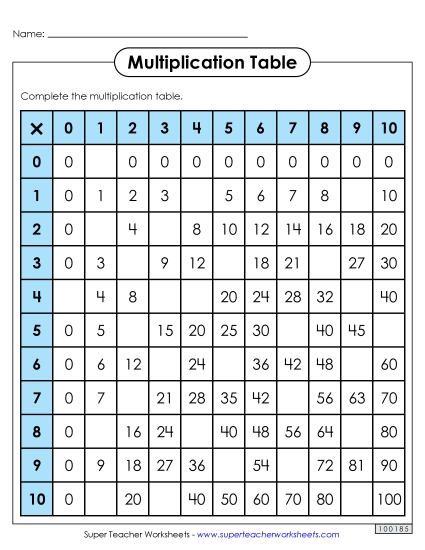
This page has a bunch of free content including lots of games, worksheets, flashcards, and activities for teaching all basic multiplication facts between 0 and 10.
On this page you'll find all of the resources you need for teaching basic facts through 12. Includes multiplication games, mystery pictures, quizzes, worksheets, and more.
Learn to use arrays to solve basic multiplication and division facts. This page includes an array table, task cards, and worksheets.
On this page you will find worksheets that teach students to use repeated addition to find the answers to multiplication facts.
In this area of our site, you'll find fact family circles, fact family houses, fact family triangles, and factor/factor/product boxes.
This page has printable multiplication tables. Includes tables that are completely filled in, partly filled in, and blank.
Here you'll find worksheets on Properties of Multiplication, including Distributive Property, Associative Property, and Commutative Property.
This page is filled with worksheets of multiplying by 2s. This is a quiz, puzzles, skip counting, and more free worksheets!
Jump to this page if you're working on multiplying numbers by 3 only.
Here are some practice worksheets and activities for teaching only the 4s times tables.
These games and worksheets focus on the number 5 as a factor. Try a free drill sheet with your class today.
If you're reviewing the 6 times tables, this page has some helpful resources.
Some of the multiplication facts with 7 as a factor can be tricky. Try these practice activities to help your students master these facts.
These printable learning activities feature 8 as a factor in basic multiplication.
When you're teaching students to multiply only by the number nine, use these printable worksheets.
These printable activities have multiplication with with 10 as one of the factors.
This page has a set of worksheets on multiplying pairs of numbers in which one or more factors are 11.
Use the printable worksheets, tools, and games on this page to help your students master basic facts with 12 as a factor.
On this page you have a large selection of 2-digit by 1-digit multiplication worksheets to choose from. (example: 32x5)
On these PDF files, students can find the products of 3-digit numbers and 1-digit numbers. (example: 371x3)
Review 4-digit by 1-digit multiplication problems with these worksheets and task cards. (example: 3,812x7)
Here's a link to a set of worksheets with 2-digit by 2-digit multiplication problems on them. Includes math riddles, a Scoot game, task cards, and more. (example: 43x19)
On these printables, your pupils will be multiplying 3-digit numbers by 2-digit numbers. (example: 778x2)
This collection features worksheets that require students to multiply by 3-digit numbers. (example: 235x129)
This page has lots of worksheets on finding the products of pairs of decimal numbers. (example: 1.3x5.6)
These worksheets will have students multiplying money amounts. (example: $5.67x3)
Use lattice grids to multiply large numbers together. Try a sample free worksheet with your students.
Learn to multiply fractions and mixed numbers with these printables.



Basic multiplication is a fundamental math skill taught in elementary school, typically beginning in second or third grade and continuing to be reinforced throughout later grades. Mastery of multiplication is crucial as it serves as the building block for more advanced mathematical concepts, such as division, fractions, and algebra. By learning multiplication, students gain the ability to solve problems more efficiently and understand the relationships between numbers, which is essential for their overall math development.
In the classroom, teachers often introduce multiplication through the use of multiplication charts and tables, which help students memorize basic multiplication facts. These visual tools provide a clear reference that students can use to understand patterns in multiplication, such as the commutative property (e.g., 3 x 4 is the same as 4 x 3). Fact families are another effective method, where students learn how multiplication and division are related by practicing groups of related problems. For example, if students know that 2 x 5 = 10, they can also understand that 10 ÷ 5 = 2. Understanding the properties of multiplication, such as the distributive property and the associative property, further deepens students' comprehension and helps them apply these concepts to more complex problems.
As students progress, they also learn to multiply decimals and money, which are critical skills for real-world applications. Teachers often use word problems and hands-on activities, such as calculating prices and totals in simulated shopping scenarios, to make these lessons practical and engaging. Visual aids like decimal grids and interactive digital tools also help students understand how multiplication works with decimals, reinforcing their skills through practice.
The content at Super Teacher Worksheets is written by actual teachers who understand that learning to multiply is vital for students' success in math and everyday life. Multiplication is used in various real-life scenarios, from calculating total costs to determining quantities in recipes or measurements. By mastering multiplication with the help of our learning aids, students not only enhance their math abilities but also develop critical thinking and problem-solving skills that are essential in both academic and real-world contexts.